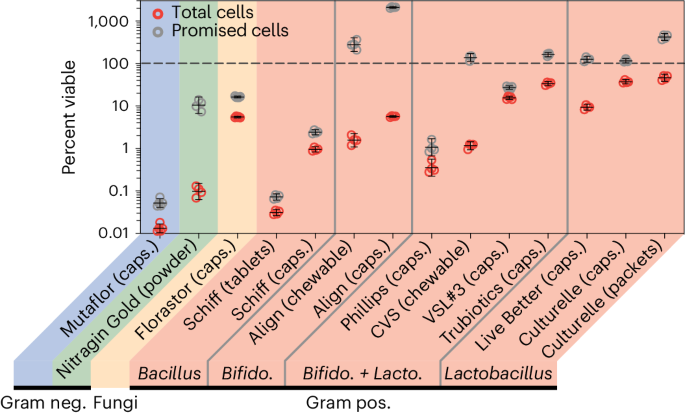Vitorino, L. C. & Bessa, L. A. Technological microbiology: development and applications. Front. Microbiol. 8, 827 (2017).
Ozdemir, T., Fedorec, A. J. H., Danino, T. & Barnes, C. P. Synthetic biology and engineered live biotherapeutics: toward increasing system complexity. Cell Syst. 7, 5–16 (2018).
Arif, I., Batool, M. & Schenk, P. M. Plant microbiome engineering: expected benefits for improved crop growth and resilience. Trends Biotechnol. 38, 1385–1396 (2020).
Menezes, A. A., Cumbers, J., Hogan, J. A. & Arkin, A. P. Towards synthetic biological approaches to resource utilization on space missions. J. R. Soc. Interface 12, 20140715 (2015).
Jimenez, M., Langer, R. & Traverso, G. Microbial therapeutics: new opportunities for drug delivery. J. Exp. Med. 216, 1005–1009 (2019).
Hyronimus, B., Le Marrec, C., Hadj Sassi, A. & Deschamps, A. Acid and bile tolerance of spore-forming lactic acid bacteria. Int. J. Food Microbiol. 61, 193–197 (2000).
Prakash, O., Nimonkar, Y. & Shouche, Y. S. Practice and prospects of microbial preservation. FEMS Microbiol. Lett. 339, 1–9 (2013).
Morgan, C. A., Herman, N., White, P. A. & Vesey, G. Preservation of micro-organisms by drying; a review. J. Microbiol. Methods 66, 183–193 (2006).
Kurtz, C. et al. Translational development of microbiome‐based therapeutics: kinetics of E. coli Nissle and engineered strains in humans and nonhuman primates. Clin. Transl. Sci. 11, 200–207 (2018).
Gurbatri, C. R. et al. Engineered probiotics for local tumor delivery of checkpoint blockade nanobodies. Sci. Transl. Med. 12, eaax0876 (2020).
Adejare, A. (ed.) Remington: The Science and Practice of Pharmacy 23rd edn (Academic Press, 2020).
Rowlett, V. W. et al. Impact of membrane phospholipid alterations in Escherichia coli on cellular function and bacterial stress adaptation. J. Bacteriol. 199, e00849–16 (2017).
Bogdanov, M., Dowhan, W. & Vitrac, H. Lipids and topological rules governing membrane protein assembly. Biochim. Biophys. Acta 1843, 1475–1488 (2014).
Sonnenborn, U. & Schulze, J. The non-pathogenic Escherichia coli strain Nissle 1917 – features of a versatile probiotic. Microb. Ecol. Health Dis. 21, 122–158 (2009).
Connor, T. R. et al. Species-wide whole genome sequencing reveals historical global spread and recent local persistence in Shigella flexneri. eLife 4, e07335 (2015).
Lapierre, L. et al. Phenotypic and genotypic characterization of virulence factors and susceptibility to antibiotics in Salmonella Infantis strains isolated from chicken meat: first findings in Chile. Animals 10, 1049 (2020).
Shad, A. A. & Shad, W. A. Shigella sonnei: virulence and antibiotic resistance. Arch. Microbiol. 203, 45–58 (2021).
Long, S. R. Rhizobium-legume nodulation: life together in the underground. Cell 56, 203–214 (1989).
Ivanova, E. P. & Skalozub, O. M. The effectiveness of the use of Sinorhizobium meliloti in the cultivation of variable alfalfa (Medicago varia Mart.). IOP Conf. Ser. Earth Environ. Sci. 962, 012017 (2022).
Deaker, R., Roughley, R. & Kennedy, I. Legume seed inoculation technology—a review. Soil Biol. Biochem. 36, 1275–1288 (2004).
Pedrini, S., Merritt, D. J., Stevens, J. & Dixon, K. Seed coating: science or marketing spin? Trends Plant Sci. 22, 106–116 (2017).
Doses in Our Daily Lives (United States Nuclear Regulatory Commission, accessed 10 November 2022); https://www.nrc.gov/about-nrc/radiation/around-us/doses-daily-lives.html
Zhang, S. et al. First measurements of the radiation dose on the lunar surface. Sci. Adv. 6, eaaz1334 (2020).
Zeitlin, C. et al. Overview of the Martian radiation environment experiment. Adv. Space Res. 33, 2204–2210 (2004).
Hassler, D. M. et al. Mars’ surface radiation environment measured with the Mars Science Laboratory’s Curiosity rover. Science 343, 1244797 (2014).
Dachev, T. P. et al. Overview of the ISS radiation environment observed during the ESA EXPOSE-R2 mission in 2014–2016. Space Weather 15, 1475–1489 (2017).
Lambert, P. A. in Russell, Hugo & Ayliffe’s Principles and Practice of Disinfection, Preservation and Sterilization 5th edn (eds Fraise, A. P. et al.) 294–305 (John Wiley & Sons, 2013).
Matin, A., Auger, E. A., Blum, P. H. & Schultz, J. E. Genetic basis of starvation survival in nondifferentiating bacteria. Annu. Rev. Microbiol. 43, 293–316 (1989).
Wasuwanich, P., Fan, G., Burke, B. & Furst, A. L. Metal-phenolic networks as tuneable spore coat mimetics. J. Mater. Chem. B 10, 7600–7606 (2022).
Milo, R., Jorgensen, P., Moran, U., Weber, G. & Springer, M. BioNumbers—the database of key numbers in molecular and cell biology. Nucleic Acids Res. 38, D750–D753 (2010).
Abràmoff, M. D., Magalhães, P. J. & Ram, S. J. Image processing with ImageJ. Biophotonics Int. 11, 36–42 (2004).
<1216> Tablet Friability (United States Pharmacopeia, 2023); https://doi.org/10.31003/USPNF_M99935_02_01
<2091> Weight Variation of Dietary Supplements (United States Pharmacopeia, 2019); https://doi.org/10.31003/USPNF_M99985_02_01
<701> Disintegration (United States Pharmacopeia, 2019); https://doi.org/10.31003/USPNF_M99460_03_01
<1217> Tablet Breaking Force (United States Pharmacopeia, 2019); https://doi.org/10.31003/USPNF_M99937_02_01
Sugawara, M. & Sadowsky, M. J. Enhanced nodulation and nodule development by nolR mutants of Sinorhizobium medicae on specific Medicago host genotypes. Mol. Plant Microbe Interact. 27, 328–335 (2014).
Barker, D. et al. Medicago truncatula Handbook (The Samuel Roberts Noble Fondation, 2006).
Legume-Microbe Interactions Laboratory. Protocol for Nodulation Assay in Pouches (Univ. Missouri, accessed 15 October 2020); https://staceylab.missouri.edu/protocol-nodulation-assay-pouches/

